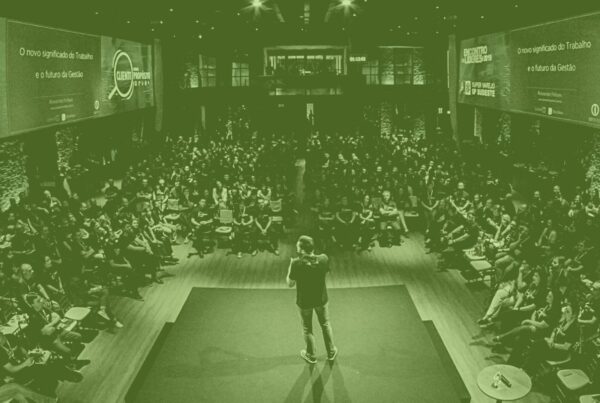We’ve said time and time again that the events industry is changed forever. The pandemic normalized virtual events and accelerated the adoption of various event tech solutions. Some might even say that the event tech evolved more since March 2020 than in the entire decade before that!
Additionally, hybrid events have established themselves as the way of the future. And so, as we find ourselves navigating this new landscape, we are encouraged to reevaluate how we do business and plan events. Traditional ways of thinking no longer serve us like they used to. If planners choose to evolve their event strategies the old way, they often struggle to allocate their budgets to cover all the new ground that’s been established since the virtual revolution. While the way forward might have been uncertain a year ago, the path is now becoming very clear: event technology should be at the core of your event strategy. If you strategize like that, everything else will fall into place.
But first, let’s put our bold claim into perspective. We need to understand how the event budgeting process worked pre-pandemic and what are the new variables in the event strategy equation. Only then can we set our eyes on the horizon and see that embracing event tech is the only way of the future. This blog post is by no means an act of fortune-telling; it’s based on current event trends and innovation. After all, as Einsteins of Events, we always put science first.
Event Strategy Starts With Goals & KPIs
Let’s start with the basics. If you’re an avid reader of our blog, you know what that means: setting SMART event goals. No two events are the same. There are different ways in which you can achieve your event goals and objectives, not to mention each event has a distinct set of attendees and stakeholders.
Use your event goals to establish your KPIs (key performance indicators), which are quantifiable and can provide useful data insights. Depending on your event, you might be interested in measuring attendee satisfaction, gross revenue, sponsorship satisfaction, NPS, or session analytics. Essentially, KPIs measure event goals and your event’s success as a whole, so they should be the leading light in your overall event strategy. After all, you have to make sure that those who are investing their time, money, and energy into your event are getting a return on that investment.
And now to the scary B-word: budget. When all our fears and worries regarding budgeting for events subside, one objective truth remains: an event budget is a tool that helps event planners achieve their goals. Nothing more, nothing less!
 Event Budgets: Traditional, Category-Based Mindset
Event Budgets: Traditional, Category-Based Mindset
Event budgets come from various sources. Among the most popular in the events industry are corporate budgets, attendee registration fees, partner sponsorships, and/or donations. Roughly speaking, planners divide their entire budget into several distinct ‘areas’ of the event.
- the event venue: a huge piece of the budget cake goes towards renting ballrooms, f&b, and room blocks.
- event production: event AV costs include all things video, audio, lighting, power, and internet.
- event design: signage, swag, event layout, meeting room design, exhibit floor design, and other event creative ingredients.
- logistics: event registration, shipping, paper materials, travel, and attendee communication.
- marketing efforts: reach your audience through ads, social media, and email marketing.
But remember, this is a traditional mindset. Event planners got along just fine with this playbook until 2019, but these days, they find themselves easily frustrated and confused. The way they thought about budget allocations all their lives doesn’t seem to work anymore!
Step Aside, Event Technology Coming Through!
The virtual and hybrid event revolution brought in a huge new player, worthy of its own category: innovative event technology. In reality, event technology has been around for ages, but it traditionally mostly fell under the domain of AV and production. Today, it enables us to reach global audiences and automate many processes, all in a cost-effective way. While many event planners didn’t concern themselves with virtual event platforms, livestreaming, remote presenters, and on-demand content before 2020, they can no longer keep their heads buried in the sand.
Understandably, the sudden, glorious arrival of software solutions feels threatening. All changes do to some extent. But here’s the good news: implementing event technology doesn’t necessarily call for a humongous budget increase. What we suggest instead is a conceptual change in our strategy mindset: make event technology the centerpiece of your event strategy, and everything else will fall into place.
 Technology At The Core Of Event Strategy
Technology At The Core Of Event Strategy
Here’s the first step you need to take to transform your event strategy frame of reference: forget about the above-mentioned traditional categories for a second. What you need to do instead is to look at event technology more holistically. Ask yourself: what is the function of an event platform? You see, event platforms perform various functions, so it’s impossible to simply put it in one pigeonhole, such as AV, IT, or logistics. After all, it could even be argued that platforms have become the new venues!
So when it comes to effective budgeting in this new era of events, it’s not the money amount that has to change, but rather the way we allocate that budget. Let’s explore some other ways in which technology and event platform features flow into different areas of your event budget.
- AV delivery of event content and pre-recording sessions: traditionally a production concern,
- event registration: an opportunity to gather data to leverage your buying power or get leads,
- attendee communication: traditionally a logistics concern,
- networking opportunities: designing the event to facilitate connections between remote attendees or both hybrid event audiences.
And here’s something to rejoice about: event technology can, in a way, save you money too!
Technology accomplishes having more people in less physical space.
If analytics, gamification, and customization don’t excite you (even though they really should!), this technological “new normal” comes with other, more traditional, perks too. By offering virtual attendance, you’re lowering the number of in-person attendees – and following the CDC’s guidelines for COVID-compliant events by doing so. Two birds with one stone!
Hybrid event budgets call for less food & beverage, lodging, travel, and venue costs. Perhaps you no longer need to rent out that hotel that’s closest to the airport. And the smaller the venue, the lower your AV costs! You can choose a modern, non-traditional venue instead.
And finally, think about all the money (and trees) you’ll be saving by going paperless. Technology has made paper completely obsolete. You can now include all your event signage and branding in your virtual event platform instead.
A Gaze Into The Future: 365 Community Model
When the event industry pivoted to virtual in 2020, content delivery took the front seat. While only the most forward-thinking thought to repurpose event content before the pandemic, it’s now becoming an accepted standard in the industry. The events industry is undergoing its very own ‘Netflixization’: many organizations are making their content available on-demand through event platforms, be it pre-recorded sessions or live session recordings.
Let’s look further into the future. In the late roaring twenties, events are no longer considered a one-off, focal experience for your attendees. The focus is on your community, the one you nurture on your virtual event platform throughout the entire year. All your event communication and content is housed and delivered through this platform and it can be viewed long after the event itself is over. Additionally, you can host virtual networking opportunities, gamified challenges, and more – whatever your futuristic heart desires.
 Overcoming Event Tech Challenges
Overcoming Event Tech Challenges
The future looks bright, innovative, and incredibly creative, but not without its challenges. As we move towards a technology-centered event strategy mindset, we also have to consider factors that stand in the way of fast adoption.
- UI/UX: it’s crucial to make event technology as user-friendly as possible; depending on your audience, you might (not) want to highlight the tech,
- knowledge deficit: event technology can be hard to keep up with as it is developing at an accelerating speed,
- resistance to change and senior staff buy-in: some organizations haven’t embraced technology at all.
The Event Strategy Of The Future!
Hopefully, we’ve made the case that event technology should be front and center in your event strategy. It can help you meet your event goals, so it really shouldn’t be something you add only if you’ve got some leftover money to spend. Throw out that traditional, category-based mindset and become the holistic event professional of the future instead.
Event technology allows event planners to dream and plan bigger with much more confidence. Being strategic has become a whole lot easier since data science entered the picture. The amount of measurable, accurate data enables planners and managers to make better-informed decisions about their event experiences.
If the future seems a little bit daunting, don’t let your fear discourage you. By being an early adopter, you’ll set yourself apart and start hitting your event goals with less work and effort. Seek support if needed – you don’t have to figure it out all by yourself. As Einsteins of Events, we are experts who know all about designing unforgettable event experiences. We help planners strategize, produce, and design their events in a way that consistently exceeds everyone’s expectations. So if you’ve got any questions about this modern way of approaching event strategy, reach out! As always, we are here to help.










